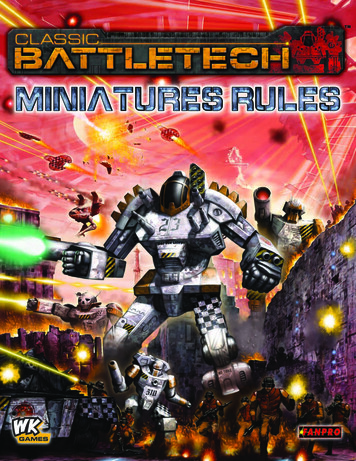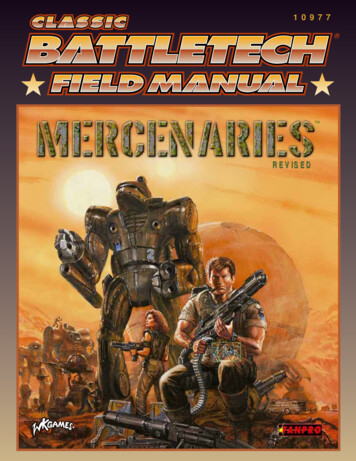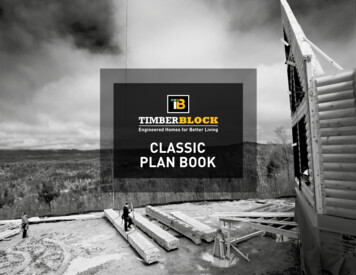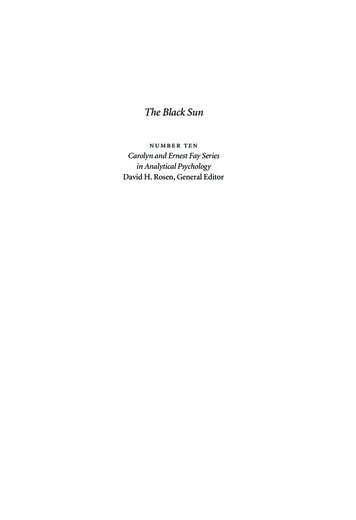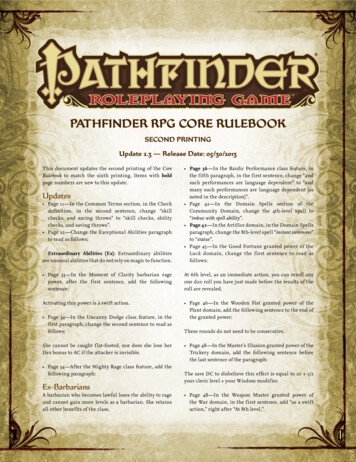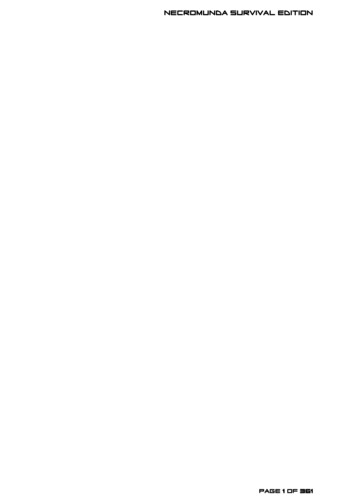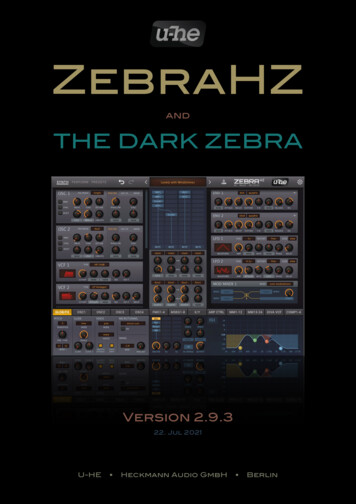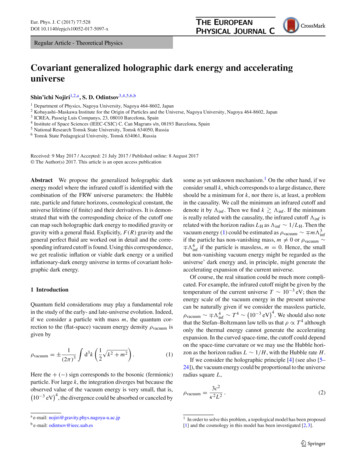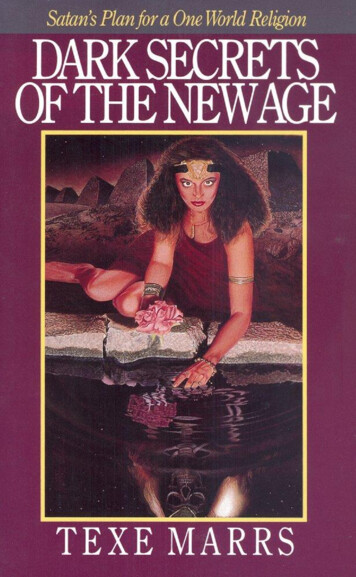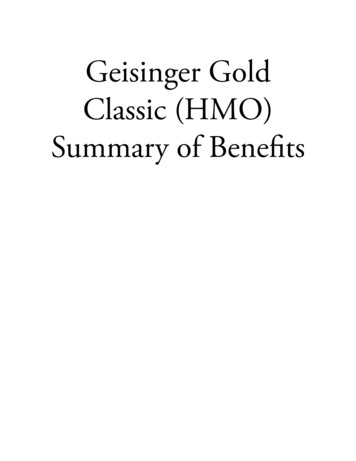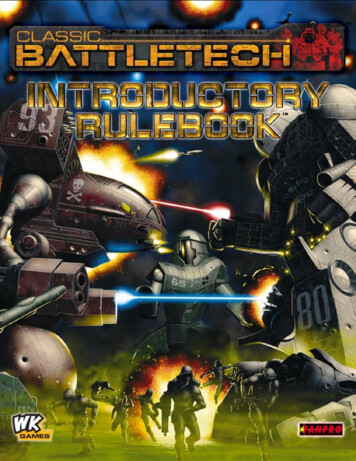
Transcription
C L A S S I C B AT T L E T E C H R U L E B O O K
TABLE OF CONTENTSINTRODUCTION5COMPONENTSBattleMech Playing PiecesRecord SheetsArmor Diagram’Mech DataWarrior DataCritical Hit TableHeat Data and Heat ScaleMapsheetsClearLight WoodsHeavy WoodsRoughWaterDice666677778888888PLAYING THE 151515151616161616Sequence of PlayInitiative PhaseMovement PhaseWeapon Attack PhasePhysical Attack PhaseHeat PhaseEnd PhaseUnequal Numbers of BattleMechsMechWarriorsSkillsSkill ImprovementDamaging a MechWarriorConsciousness RollsMovement BasicsMovement DirectionFacingFacing ChangeMovement ModesStanding StillWalkingRunningJumpingMovement ActionsFacing ChangeDropping to the GroundStanding UpStacking Table of ContentsAccidental ViolationPiloting Skill RollsMaking Piloting Skill RollsFalling16161618COMBAT1919202020202121WEAPON 032Attack DeclarationTorso TwistLine of SightLevelIntervening TerrainPartial CoverWater HexesAmmunition ExpenditureFiring ArcsForward ArcLeft Side ArcRight Side ArcRear ArcRotating the Firing ArcsFiring WeaponsBase To-Hit NumberModified To-Hit NumberTo-Hit ModifiersProne BattleMechsTo-Hit RollHit LocationDamageRecording DamageDamage ResolutionTransferring DamageCritical DamageBattleMech Critical HitsBattleMech Critical Hit EffectsDestroying a BattleMechPHYSICAL ATTACKSBase To-Hit NumberModified To-Hit NumberPunch AttacksClub AttacksFinding A ClubPhysical Weapon AttacksPush AttacksKick AttacksCharge Attacks32323233333434343434
DamageLocation After AttackFallsDeath from Above AttacksWeapon Attack PhaseDamage to TargetDamage to AttackerLocation After AttackFallsDifferent LevelsProne BattleMechsPhysical Attacks Against Prone BattleMechsBattleMech DisplacementAccidental Falls from AboveDomino EffectHEATHeat PointsBuilding Up HeatRecording Heat BuildupEffects of HeatMovement EffectsWeapon Attack EffectsShutdown EffectsAmmunition EffectsMechWarrior EffectsScenariosScenario 1: Final ExamScenario 2: Trial by FireScenario 3: Divide and ConquerPlaying BattleTechBattleTech TacticsInitiativeMovementWeapon AttacksPhysical AttacksBattleTech ForcesScoutsStrikersSkirmishersBrawlersMissile BoatsSnipersJuggernautsCONSTRUCTIONDesign the ChassisAdd Other EquipmentEQUIPMENTblank record 556616364CREDITSBattleTech Original DesignJordan K. WeismanL. Ross Babcock IIISam LewisProject DevelopmentRandall N. BillsPerpetual War byRandall N. BillsA Brief History of the Inner Sphere byMichael A. StackpoleDiane Piron-GelmanChristoffer "Bones" TrossenFactions byDiane Piron-GelmanScenarios and Playing BattleTech byBryan NystulMaterial from Technical Readout: 3025 byBlaine L. PardoeBoy F. Petersen, Jr.Anthony PryorDale L. KemperShaun DuncanL. R. Butch LeeperL. Ross Babcock IIIJordan K. WeismanForest BrownKevin SteinMaterial from MechWarrior, Second Edition, byDonna IppolitoSam LewisMaterial from 20-Year Update byJim MusserDonna IppolitoBoy F. Petersen, Jr.Material from BattleTech Master Rules, byBryan NystulProject EditingMichelle LyonsBattleTech Line DeveloperRandall N. BillsTable of Contents
Production StaffArt DirectionRandall N. BillsGraphic Design & LayoutJim NelsonLayout UpdateAdam JuryClassic BattleTech Rulebook Cover ArtFranz VohwinkelClassic BattleTech Universe Cover ArtFranz VohwinkelB&W IllustrationsMathew PlogColor IllustrationsFranz VohwnkelPoster Map of the Inner SphereØystein TvedtenAcknowledgementsThe following authors need to be thanked for helping in one way or another to successfully shape a living andbreathing universe over the course of these last fifteen years:Ken St. Andre, Dorothy Elizabeth Baker, Samuel Brown BakerII, Herbert A. Beas II, Mike Bently, Randall N. Bills, Mark Bloom,David Boyle, Hugh Browne, Jim Brunk, Alex Bund, Brent Carter,Robert N. Charrette, Loren L. Coleman, Dave Coriveau, ChuckCrane, Robert Cruz, Warner Doles, Elizabeth T. Danforth, PhillipJ. DeLuca, Shaun Duncan, D. Brad Frazee, Tara Gallagher, EricGarvis, Cory Glaberson, Adam Gratun, C. R. Green, Dan “Flake”Grendell, Thomas S. Gressman, Eric Hart, Chris Hartford, MichaelT. Herbert, Clare W. Hess, Karl Hiesterman, Detlef Howe, ToddHuettel, Lisa M. Hunt, Walter H. Hunt, Christopher Hussey,Donna Ippolito, Evan Jamieson, Scott Jenkins, Stuart Johnson,J. Andrew Keith, William H. Keith, Jr., Dale L. Kemper, StephenKenson, Peter Killinger, Patrick Kirkland, Camille Klein, RodneyKnox, Michael Koennecke, James Lanigan, Patrick L. Larkin,David Ladyman, Jeffrey Layton, Michael Lee, Sam Lewis, BryanLiB randi, James D. Long, Christine Mackay, Laurie Mair, GeneMarcil, Stephané I. Matis, Ardath Mayhar, Patrick McCormack,David L. McCulloch, Richard K. Meyer, Victor Milán, Tanja Möstel,Michael Mulvihill, Sharon Turner Mulvihill, Jim Musser, BryanNystul, Mike Nystul, George O’Dahjungle, Mel Odom, HeikoOertel, Mike O’Green, Blaine Lee Pardoe, Geoff Pass, MichaelPellicciotti, Bear Peters, Tom Peters, Boy F. Petersen, Jr., DonaldG. Phillips, Diane Piron-Gelman, Anthony Pryor, Susan Putney,Peter L. Rice, William Scammell, Lester W. Smith, Peter Smith,Brant Sponberg, Jerry Stenson, Rick David Stuart, John Thiesen,Robert Thurston, Christoffer Trossen, Ashley Watkins, Robt.Wells, Wm. John Wheeler, Andreas Zuber, Gabriel Zupcan andlast, but certainly not least, L. Ross Babcock III, Jordan Weismanand Michael A. Stackpole.To the sculptors past and present, who have created a vast,award winning BattleTech miniature line: C. Atkin, B. Bugge, B.Charrette, J. Garrity, S. Garrity, J. Grace, J. Guthrie, B. Hubbuch, J.Johnson, R. Kerr, R. Kyde, P. Lewis, T. Meier, S. Saunders, D. Summers,W. Vail, G. Valley, J. VanSchaik, J. Wilhelm, J. Winter and any oneelse we might have missed.Additionally, to all of the artists who have breathed visuallife into such a vibrant universe. Of particular note are DougChaffee, Mark Zug, Les Dorshied, Jim Nelson, Chris Moeller,Kevin McCann, Duane Loose, Franz Vohwinkel, Fred Hooper, andMathew Plog.To all of the editors that have turned author manuscriptsinto printed products—thanks!Finally, to every licensee that BattleTech has ever had; thankyou for bringing the wonderful world of BattleTech to new audiences and unexpected horizons.PlaytestersMuch as we appreciate and recognize the efforts of thosewho have gone before us, the list is too extensive to reprint here.Thanks again to all those who have worked to make this gamewhat it is today.ThanksThanks to all of the BattleTech fans, past, present and future.You’ve made this twenty year ride possible and we hope you’lljoin us for another exciting and fun filled fifteen years!Special ThanksTo Mathew Plog and especially Franz Vohwinkel, who tookmy art notes and under a very tight deadline created one of thebest single bodies of BattleTech artwork ever published; to JimNelson who took the extra time to create a graphic style andpresentation that takes both the Classic BattleTech Universe andClassic BattleTech Introductory Rulebook to a new level.Copyright 2002-2006 WizKids, Inc. All Rights Reserved. Classic BattleTech,BattleTech, ’Mech, BattleMech, MechWarrior and WK Games logo are registeredtrademarks and/or trademarks of WizKids, Inc in the United States and/or othercountries. No part of this work may be reproduced, stored in a retrieval system, ortransmitted in any form or by any means, without the prior permission in writingof the Copyright Owner, nor be otherwise circulated in any form other than thatin which it is published.Version 2.0 (October 2006) Published by FanPro LLC1608 N. Milwaukee Suite 1005 Chicago, IL 60647Find us online:Precentor martial@classicbattletech.com(e-mail address for any Classic BattleTech l Classic BattleTech web pages)http://www.fanprogames.com(FanPro web icial MechWarrior web pages)http://www.wizkidsgames.com(WizKids web pages)http://www.studio2publishing.com(online ordering, sales and distribution) Credits
INTRODUCTIONClassic BattleTech (CBT) simulates combat betweenvarious military vehicles in the thirty-first century. Thekings of the battlefield are the 30-foot-tall humanoidtitans known as BattleMechs. However, a myriad othermilitary units bring additional fun to any game, fromCombat Vehicles to Support Vehicles, infantry to aerospaceunits and more.While the full depth and enjoyment of Classic BattleTechcan be experienced through a combined-arms use of ’Mechs,vehicles, infantry and so on, the following three-tiered systemhas been created to simply and easily transition players intoeverything Classic BattleTech has to offer.The Quick-Start Rules introduce players to the basic concepts of the game through ’Mech vs. ’Mech combat; a sneakpeak at similar quick-start rules for vehicles and infantry are alsogiven. The Classic BattleTech Introductory Rules—found in thisrulebook—then broaden and flesh out the rules for the game,staying with ’Mech vs. ’Mech combat for ease of understandingand enjoyment. All of that then leaves a player prepared to leapinto Classic BattleTech Total Warfare and the complete rules forall aspects and units of standard Classic BattleTech play.Classic BattleTech Quick-Start RulesPlayers new to the BattleTech game system should download and read the Classic BattleTech Quick-Start Rules (seewww.classicbattletech.com/leap). The Quick-Start Rules lay outthe basic rules of the game and allows players to jump right in;for the fictional backdrop across which the Classic BattleTechgame is played, players can download and read the ClassicBattleTech Universe book (see www.classicbattletech.com/leap).Once players have tackled the Green section of the QuickStart Rules, they’ll be primed to move on to these introductoryrules. While players are free to experience the Veteran and Elitesection of the Quick-Start Rules before moving to the introductory rules found in this rulebook, those sections introducevehicles and infantry, whose full rules sets are found in ClassicBattleTech Total Warfare.Classic BattleTech Introductory RulesThe rules presented in the Classic BattleTech IntroductoryRulebook are considered the introductory rules of ClassicBattleTech. The introductory rules use the technology available in 3025, including all ’Mechs and weapons described inTechnical Readout: 3025.The Classic BattleTech Introductory Rulebook is dividedinto seven main sections. Playing the Game outlines the basicsequence of BattleTech play—the different phases of a gameturn and the fundamental game mechanics. The Movementsection describes the rules governing BattleMech movement.Combat contains the rules for resolving BattleMech weaponsand physical attacks. Scenarios contains three BattleTech scenarios to test your skills and familiarize you with play, as well asdemonstrating the variety of possible BattleTech missions. Thesescenarios can be played again and again or modified to createan endless array of different battles. Playing BattleTech providesan in-depth look at the tactics involved in becoming an expertplayer, once the basics have been learned. Construction provides instructions for custom-designing new ’Mechs from theground up. Finally, the Equipment section provides descriptionsfor various weapons carried by BattleMechs.Readers new to BattleTech should note that the game’sfictional universe has progressed chronologically since it firstappeared in 1985. Millions of words worth of background fiction has been published in game supplements, scenarios andsourcebooks—as well as in the numerous BattleTech novels,which represent some of the richest back-ground source material for the game.Currently, BattleTech is set in the year 3071-72. Though theClassic BattleTech Universe book brings new players up to speedcirca 3067, the rules are specifically kept at the year 3049,before a major technological innovation introduced manyadvanced weapons and equipment. As this is an introductoryrules set, those more advanced rules and weaponry are notcovered here.Classic BattleTech Standard RulesThe rules presented in Total Warfare are considered thestandard rules of Classic BattleTech; the rules expand on theintroductory rules by adding various advanced technologiesand additional rules for infantry, vehicles and so on, as describedin the rest of the Technical Readout series beyond 3025. Theyrepresent all tournament appropriate rules: the “big” ClassicBattleTech tournaments run directly by FanPro at the OriginsInternational Games Expo , any Gen Con Game Fair and manyother conventions all use the rules presented in Total Warfare.Once players have familiarized themselves with the rulespresented in the Introductory Rulebook and tackled severalgames, they can move on to the standard rules of the game aspresented in Total Warfare.Note that if players have not already done so, the Veteranand Elite section of the Classic BattleTech Quick-Start Rules layout the basics of vehicle and infantry combat and are a prefectway to catch of glimpse of all that Total Warfare has to offer(see www.classicbattletech.com/leap).Introduction
ComponentsPlayers will find a series of PDF downloads atwww.classicbattletech.com/leap which provideadditional material or act as game aids to the ClassicBattleTech Introductory Rulebook.Classic BattleTech Quick-Start RulesAs described in the introduction, the Quick-Start Rules arean easy way to leap into the action of the Classic BattleTechgame system and lay the ground work for the rules provided inthis rulebook.The Quick-Start Rules also contain a map that players cancontinue to use as they begin playing with the rules in theIntroductory Rulebook.Classic BattleTech UniverseThe perfect companion to the rulebook, the ClassicBattleTech Universe book provides information on the fictionalbackdrop against which the exciting games of Classic BattleTechtake place.Classic BattleTech Introductory Record SheetsPre-generated record sheets covering the twenty-four’Mechs detailed in the Classic BattleTech Universe book.The Classic BattleTech Introductory Record Sheets also contains counters for each of those twenty-four ’Mechs, allowingplayers to print and cut-out ready-made playing pieces.Additional Materials Needed to Play the GamePlayers will need to provide two six-sided dice.Additionally, while the map provided in the Classic BattleTechQuick-Start Rules can be used when playing games using theIntroductory Rulebook, players will quickly find that one of theeasiest ways to make an already played scenario fresh and new isto play it on a different map. Map Set Compilation #1 (publishedby FanPro LLC), contains 24 maps, providing a wide selection ofready-made terrain for game play; note that the scenarios in theScenario section are best played using the Classic BattleTech map,which is contained in Classic BattleTech Map Set Compilation #1.battlemech playing piecesBattleMechs—the most powerful ground-based warmachines ever built—dominate the battlefields of the thirtyfirst century. These huge, humanoid vehicles stand ten to twelvemeters tall and weigh as much as 100 tons. They are faster, moremaneuverable, better armored and more heavily armed than anyother combat unit. Equipped with particle projector cannons,lasers, rapid-fire autocannons and missiles, these behemothspack enough firepower to flatten everything but another ’Mech. ComponentsAs noted above, the Classic BattleTech Introductory RecordSheets contains ready-made playing pieces that represent twenty-four different BattleMech designs. These playing pieces areused to show the position of each ’Mech on the mapsheet andto keep track of its movement during the game. To assemble theplaying pieces, cut them out along the dotted lines, includingcutting the slots into the front and rear tabs. Once that’s done,fold both tabs over and scissor the two slots together.In place of these pieces, players can use BattleTech miniatures. Iron Wind Metals manufactures a complete line of miniatures designed for use with BattleTech mapsheets (see www.ironwindmetals.com). If playing pieces and miniatures areunavailable, player may use counters or any other item to represent each BattleMech. Nearly any appropriately sized itemwill do, as long as it contains a mark to indicate which way theBattleMech is facing at all times.Terminology: In these rules, the term “unit” refers to anymobile element that can be fielded in a Classic BattleTech game.While this only applies to BattleMechs for these introductoryrules (i.e. the word ’Mech and unit are interchangeable in theserules), the definition is introduced now to make an easier transition when other units (infantry, vehicles and so on) are added tothe rules, either through the Classic BattleTech Quick-Start Rules,or Classic BattleTech Total Warfare.RECORD SHEETSBattleMech Record Sheets enable a player to easily monitor the operating status of his ’Mechs. Each sheet provides asummary of the armor and weapons capabilities of a particularmachine, spaces to record any damage the ’Mech sustains during combat, and other useful information. Every record sheetcontains five parts: an Armor Diagram section, ’Mech Data section, Warrior Data section, Critical Hit Table, and Heat Scale.Armor DiagramThe Armor Diagram on the to right-hand side of therecord sheet shows the arrangement of armor plating on theBattleMech. Each circle represents a point of armor. Circlesin excess of a specific BattleMech’s armor plating are filled inprior to play. As weapon hits destroy a ’Mech’s armor, the playerchecks off the armor by filling in the affected circles.The Internal Structure Diagram, directly below the ArmorDiagram, shows the locations of the BattleMech’s internalstructures and is used to track damage to those locations. TheDamage Transfer Diagram, which appears at the bottom of theCritical Hit Table, shows where damage will be taken or transferred when a part of the BattleMech already destroyed takesadditional damage. (For a complete explanation of damage
rules and directions for using the different armor diagrams, see the Combat section, beginning on p. 19).For ease of reference during gameplay, next to the name of each locationon both the armor diagram, as well asthe internal structure diagram, a line isprovided to fill in that section’s startingArmor Value (or in the case of the internal structure, the starting internal structure value).’Mech DataLocated in the upper left-hand corner,this section of the record sheet lists theBattleMech’s most important statistics,including the BattleMech type, tonnage,movement, and weapons inventory.Warrior DataThis section lists the name, skills andcondition of the MechWarrior pilotingthe BattleMech.Critical Hit TableThe Critical Hit Table shows thephysical location of the BattleMech’scritical equipment, weapons, andammunition. Each part of the ’Mech’sbody, such as the Left Arm, Right Leg, orCenter Torso, is referred to as a location.Each line in a location (there are six inthe head and legs, twelve in other locations) is referred to as a critical slot, orsimply slot. Each slot usually representsa particular weapon or other piece ofequipment susceptible to destruction.Most equipment occupies so muchspace in the ’Mech that it requires multiple slots on the table.Heat Data and Heat ScaleLocated in the bottom right-handcorner, the Heat Data and Heat Scalehelp the player track each ’Mech’s internal heat buildup, as well as indicate howmany heat sinks a ’Mech mounts (circlesunderneath the numerical value in theTMARMOR DIAGRAMHead (Left Torso( ))Right Torso( )’MECH RECORD SHEET'MECH DATAWARRIOR DATAType:Name:Movement Points:Walking:Running:Jumping:Gunnery Skill:Tonnage:Hits TakenConsciousness#Weapons & Equipment InventoryQty TypePiloting Skill:13253 4 5 67 10 11 Dead(hexes)Loc Ht Dmg Min Sht Med LngCenterTorso( )Left Arm( )LeftLeg( )Right Arm( )RightLeg( )CenterTorsoRear ( )LeftTorso Rear( )CRITICAL HIT TABLELeft Arm1. Life Support2. Sensors3. Cockpit4.5. Sensors6. Life Support1. Shoulder2. Upper Arm ActuatorLower Arm Actuator1-3 3.4. Hand Actuator5.6.1.2.4-6 3.4.5.6.1.2.1-3 3.4.5.6.Left TorsoCenter Torso1-31.2.3.4.5.6.4-61. Gyro2. Engine3. Engine4. Engine5.6.EngineEngineEngineGyroGyroGyroEngine HitsGyro HitsSensor HitsLife Support1.2.4-6 3.4.5.6.Right Arm1. Shoulder2. Upper Arm ActuatorLower Arm Actuator1-3 3.4. Hand Actuator5.6.1.2.1-3 3.4.5.6.Head)Right TorsoHeatScaleOverflowRight Torso ()30*2928*27RightArm( )CenterTorso( )26*25*24*23*22*LeftLeg( )RightLeg( )2120*19*18*17*16HEAT DATA15*Heat Sinks:1.2.4-6 3.4.5.6.Right LegDamage TransferDiagramLeft Torso (LeftArm( )1.2.4-6 3.4.5.6.Left Leg1. Hip2. Upper Leg Actuator3. Lower Leg Actuator4. Foot Actuator5.6.RightTorso Rear( )INTERNAL STRUCTURE DIAGRAMHead1. Hip2. Upper Leg Actuator3. Lower Leg Actuator4. Foot Actuator5.6.HeatEffectsLevel*30 Shutdown28 Ammo Exp. avoid on 8 26 Shutdown, avoid on 10 25 –5 Movement Points24 4 Modifier to Fire23 Ammo Exp. avoid on 6 22 Shutdown, avoid on 8 20 –4 Movement Points19 Ammo Exp. avoid on 4 18 Shutdown, avoid on 6 17 3 Modifier to Fire15 –3 Movement Points14 Shutdown, avoid on 4 13 2 Modifier to Fire10 –2 Movement Points8 1 Modifier to Fire5 –1 Movement Points14*13*121110*98*765*43210 2006 WizKids, Inc. Classic BattleTech, ’Mech and BattleMech are trademarks of WizKids, Inc. All rights reserved.Permission to photocopy for personal use.Components
Heat Data section allow players to mark off heat sinks as theyare damaged). As heat builds up, the player checks off the boxesin the Heat Scale from low to high (usually with a pencil, as heatwill fluctuate up and won the Heat Scale all through a game).At certain levels of heat buildup (those heat levels with asterisks), corresponding information in the Heat Data describes theheat’s effect on the ’Mech’s operation. The blank space markedHeat Overflow at the top of the Heat Scale is used to record heatgenerated in excess of 30 points.MAPSHEETSThe 22-by-17 inch mapsheets used in BattleTechare divided into six-sidedareas called hexes (shortfor hexagon). The players use these hexes toregulate movement andcombat by moving unitsfrom hex to hex duringa turn. Each hex on themapsheet represents anarea of ground 30 metersacross (roughly 100 feet).The forests, rivers, hillsand rough areas on aBattleTech mapsheetrepresent a typical mixture of the terrain found on the habitableworlds of the Inner Sphere. The following symbols representeach type of terrain as described, and the accompanying textgives an overview of the terrain’s effects. Specific rules regarding the effect of terrain on movement and combat appear in theMovement and Combat sections.LevelThe level of a hex is the height to which it rises above theprevailing terrain. All terrain has a level; the level of a hex isindependent of the type of terrain it contains, such as woods orwater. Hexes with levels higher than 0 are also referred to as hills.If it is not marked on the map, assume a hex’s level is 0.This height is expressed in terms of levels. Level 1 is 6 metershigh (waist-high to a BattleMech): a BattleMech standing behinda Level 1 hill may be partially hidden. Level 2 terrain is 12 metershigh (the same height as a BattleMech): a BattleMech standingbehind Level 2 terrain is completely hidden. Level 3 terrain is 18meters high, and so on. The level of a hex is considered equal tothe highest level present in it.Sublevels: Hexes with levels lower than 0 are referred to assinkholes. These hexes are marked in Sublevels that correspondto levels in reverse; a Sublevel 1 hex is 6 meters deep, while aSublevel 2 hex is 12 meters deep and so on.If any part of a hex contains a sublevel, the entire hex isconsidered to be the deepest sublevel marked in the hex. Theexception to this rule is if there is also a level greater than 0marked in the same hex, in which case the level of the hill takesprecedence in the hex as described above. ComponentsClearClear terrain represents fields, meadows andother grasslands. The ground is firm and may begently rolling, but its level does not change significantly from one side of the hex to the other. If a hex isnot clearly marked as containing another terrain type,assume it is Clear.Light WoodsLight woods terrain is covered with sparse treesof up to 12 meters in height. BattleMechs cannotcross this terrain as easily as clear terrain. Unless thewood is relatively large, units may have line of sightthrough light woods. When Light Woods affect line ofsight, they do so for 2 levels above the level of their hex.(See Intervening Terrain in Combat, p. 20).Heavy WoodsHeavily wooded terrain is covered thickly with12-meter-tall trees, making movement throughthese areas very difficult. Light woods often borderheavy woods. It is very difficult to see through heavywoods. As with Light Woods, Heavy Woods affect lineof sight for 2 levels above the level of their hex. (SeeIntervening Terrain in Combat, p. 20).RoughRough terrain represents broken, rocky and jumbled ground. Though firm, the unevenness of this typeof terrain makes it more difficult to cross than clearterrain. Commonly encountered near cliffs and bluffs,rough ground may also be formed as a result of thedestruction of woods.WaterWater terrain hexes are covered by streams, rivers, swamps, ponds or lakes. A Water hex is defined bydepth levels (see Levels). Depth 0 water is very shallow, only ankle-deep on a BattleMech, and representsterrain such as streams, swamps or shallow ponds.Depth 1 water is 6 meters deep, or 1 level below groundlevel (about waist-high on a BattleMech). Depth 2 water is 12meters deep, deep enough to just cover a BattleMech. Depth 3water is 18 meters deep, and so on.Water hexes effectively have two levels, the surface of thewater and the bed (or floor) of the body of water they represent.The level of the surface is equal to the level of the hex. The levelof the bed is equal to the level of the hex minus the depth of thewater. For example, for a Depth 2 river in a Level 3 hex, the surfaceis at Level 3 while the riverbed is at Level 1.Even when a shallow stream fills only part of a hex, thatentire hex is considered a Water hex, as described in Sublevels.DiceBattleTech requires players to use two six-sided dice, preferably of two different colors. If the situation requires the player toroll one die, the rules indicate this in shorthand as 1D6. Unlessotherwise noted, the abbreviation 2D6 means the player rollsboth dice and adds the results together.
PLAYING THE GAMEThis section provides the sequence of play for BattleTechand presents the basic rules for playing MechWarriorsin BattleTech.To begin a game, the players lay out the BattleTechmapsheets on a table or the floor either in a wayagreed upon by all players, or—if using a FanPro LLC or FASAscenario pack—according to the Game Setup of the scenario tobe played.Next, the players fill out record sheets for each of theirBattleMechs involved in the battle. If desired, players can pho-tocopy the appropriate record sheets provided in CBT. (The various BattleTech Technical Readout books contain a large selectionof additional ’Mech designs, and the corresponding BattleTechRecord Sheets contain completed record sheets for thesedesigns.) If all players agree, BattleMechs may be created usingthe Construction rules, p. 55.SEQUENCE OF PLAYA BattleTech game consists of a series of turns. Each turnrepresents 10 seconds of game time. During each turn, allPlaying the Game
BattleMechs on the map have an opportunity to move and firetheir weapons. Each turn consists of several smaller segmentsof time, called phases. During each phase, players will take onespecific type of action, such as movement or combat.The players execute the phases of every turn in a specificorder. Specific actions, movement, effects of damage, and so onare fully explained in separate sections later in this book. Eachturn includes the following phases, performed in order:Initiative PhaseMovement PhaseWeapon Attack PhasePhysical Attack PhaseHeat PhaseEnd PhaseINITIATIVE PHASE1. One player from each side rolls 2D6 and adds the resultstogether to determine his team’s Initiative. The team with thehigher result has the Initiative throughout the turn. Reroll a tiedresult.Movement Phase2. The team that lost the Initiative chooses one BattleMechand moves it first. If this team has more units than the teamthat won the Initiative, it may need to move more than oneBattleMech, as described in Unequal Numbers of BattleMechs,p. 11.3. The team that won the Initiative moves one BattleMech.If this team has more BattleMechs than the team that lost theInitiative, it may need to move more than one BattleMech, asdescribed in Unequal Numbers of BattleMechs, p. 11.Movement alternates between sides until all BattleMechshave been moved. Each time a player is required to move aBattleMech, he may designate a movement for any BattleMechthat has not been destroyed, even if the move is to simply stand(or lie) immobile.10 The act of declaring attacks alternates between playersuntil all fire has been declared. Each time a player is required todeclare attacks for a BattleMech, he may declare an attack forany BattleMech that has not been destroyed, even if the declaration is not to make any attacks.6. Weapons fire is resolved one BattleMech at a time. Allweapons attacks by one BattleMech should be resolved beforethose of the next BattleMech in order for the players to moreeasily track which weapons have fired.Note that all declared attacks must be made, even if theintended target is destroyed before all attacks against it havebeen resolved; all declared weapons fire must be resolved forthe purpose of tracking ammunition and heat. In addition, alldeclared attacks must be made because the Weapon AttackPhase represents only a few seconds of time, during which thegeneral confusion of battle makes it impossible to change t
Classic BattleTech Universe book brings new players up to speed circa 3067, the rules are specifically kept at the year 3049, before a major technological innovation introduced many advanced weapons and equipment. As this is an introductory

